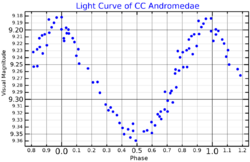Astronomy:CC Andromedae
| Observation data Equinox J2000.0]] (ICRS) | |
|---|---|
| Constellation | Andromeda |
| Right ascension | 00h 43m 48.01231s[2] |
| Declination | +42° 16′ 55.76902″[2] |
| Apparent magnitude (V) | 9.19 – 9.46 variable [3] |
| Characteristics | |
| Spectral type | F3IV-V[3] |
| Apparent magnitude (R) | 9.40[4] |
| Apparent magnitude (B) | 9.693[5] |
| Apparent magnitude (V) | 9.347[5] |
| Apparent magnitude (G) | 9.3034[2] |
| Apparent magnitude (J) | 8.586[6] |
| Apparent magnitude (H) | 8.526[6] |
| Apparent magnitude (K) | 8.49[6] |
| U−B color index | 0.11[7] |
| B−V color index | 0.3162[5] |
| Variable type | δ Sct[3] |
| Astrometry | |
| Radial velocity (Rv) | −9.5±1.2[8] km/s |
| Proper motion (μ) | RA: -8.198[2] mas/yr Dec.: -3.920[2] mas/yr |
| Parallax (π) | 2.6339 ± 0.0175[2] mas |
| Distance | 1,238 ± 8 ly (380 ± 3 pc) |
| Absolute bolometric magnitude (Mbol) | 1.25[7] |
| Details[7] | |
| Mass | 1.98 M☉ |
| Radius | 3.04 R☉ |
| Surface gravity (log g) | 3.77±0.1 cgs |
| Temperature | 7,400 K |
| Rotational velocity (v sin i) | 20 km/s |
| Other designations | |
| Database references | |
| SIMBAD | data |
CC Andromedae (CC And) is a variable star in the constellation Andromeda. It is a pulsating star of the Delta Scuti type, with an apparent visual magnitude that varies between 9.19 and 9.46 with a periodicity of 3 hours.[3]
The variability of CC Andromedae was discovered accidentally, by Olin Eggen on October 22, 1952, when he attempted to use it as a comparison star for measuring the brightness and colors of stars in the Andromeda Galaxy which is about one degree away from CC Andromedae.[9]
The stellar classification of CC Andromedae is F3IV-V, as it shows intermediate characteristics between a subgiant and a main sequence star. The brightness variations are the result of 7 different pulsation modes, most of which are non-radial,[7] making it a suspected Gamma Doradus variable too.[10]
References
- ↑ Rousseau, C.; Bourassa, J. I.; Milone, E. F. (July 1988). "VBI Light Curves of CC And". Information Bulletin on Variable Stars 3211 (1): 1. Bibcode: 1988IBVS.3211....1R. https://ui.adsabs.harvard.edu/abs/1988IBVS.3211....1R. Retrieved 7 October 2021.
- ↑ 2.0 2.1 2.2 2.3 2.4 2.5 Brown, A. G. A. (2021). "Gaia Early Data Release 3: Summary of the contents and survey properties". Astronomy & Astrophysics 649: A1. doi:10.1051/0004-6361/202039657. Bibcode: 2021A&A...649A...1G. Gaia EDR3 record for this source at VizieR.
- ↑ 3.0 3.1 3.2 3.3 CC And, database entry, Combined General Catalog of Variable Stars (GCVS4.2, 2004 Ed.), N. N. Samus, O. V. Durlevich, et al., CDS ID II/250 Accessed on line 2018-10-29.
- ↑ Database entry, VizieR Online Data Catalog: UCAC4 Catalogue (Zacharias+, 2012), N. Zacharias et al., CDS ID I/322A Accessed on line 2018-10-29.
- ↑ 5.0 5.1 5.2 Høg, E.; Fabricius, C.; Makarov, V. V.; Urban, S.; Corbin, T.; Wycoff, G.; Bastian, U.; Schwekendiek, P. et al. (2000), "The Tycho-2 catalogue of the 2.5 million brightest stars", Astronomy & Astrophysics 355: L27–L30, Bibcode: 2000A&A...355L..27H.
- ↑ 6.0 6.1 6.2 Cutri, Roc M.; Skrutskie, Michael F.; Van Dyk, Schuyler D.; Beichman, Charles A.; Carpenter, John M.; Chester, Thomas; Cambresy, Laurent; Evans, Tracey E. et al. (2003). "VizieR Online Data Catalog: 2MASS All-Sky Catalog of Point Sources (Cutri+ 2003)". CDS/ADC Collection of Electronic Catalogues 2246: II/246. Bibcode: 2003yCat.2246....0C. http://vizier.u-strasbg.fr/viz-bin/VizieR?-source=II/246.
- ↑ 7.0 7.1 7.2 7.3 Fu, J. -N.; Jiang, S. Y. (1995). "The multiple frequencies of the δ Scuti variable CC Andromedae.". Astronomy and Astrophysics Supplement 110: 303. Bibcode: 1995A&AS..110..303F.
- ↑ de Bruijne, J. H. J.; Eilers, A.-C. (October 2012), "Radial velocities for the HIPPARCOS-Gaia Hundred-Thousand-Proper-Motion project", Astronomy & Astrophysics 546: 14, doi:10.1051/0004-6361/201219219, A61, Bibcode: 2012A&A...546A..61D.
- ↑ Lindblad, Per Olof; Eggen, Olin J. (December 1953). "A New Short-Period Variable Star: BD+41°119". Publications of the Astronomical Society of the Pacific 65 (387): 291. doi:10.1086/126629. Bibcode: 1953PASP...65..291L. https://articles.adsabs.harvard.edu/pdf/1953PASP...65..291L. Retrieved 31 March 2023.
- ↑ Liakos, Alexios; Niarchos, Panagiotis (2016), "Catalogue and properties of δ Scuti stars in binaries", Monthly Notices of the Royal Astronomical Society 465 (1): 1181–1200, doi:10.1093/mnras/stw2756, Bibcode: 2017MNRAS.465.1181L
 |


